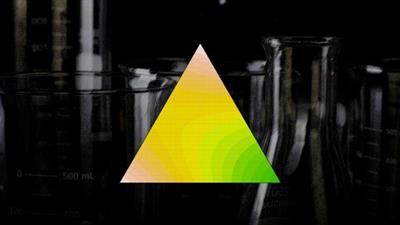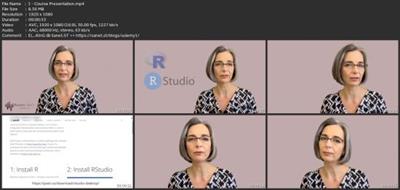- Thread Starter
- #1

Design Of Experiments For Mixtures
Published 11/2023
MP4 | Video: h264, 1920x1080 | Audio: AAC, 44.1 KHz
Language: English | Size: 720.51 MB | Duration: 1h 36m
Mixture Designs to Optimize Formulations Using R: Simplex Lattice Designs, Simplex Centroid Designs, D-Optimal Designs.
Published 11/2023
MP4 | Video: h264, 1920x1080 | Audio: AAC, 44.1 KHz
Language: English | Size: 720.51 MB | Duration: 1h 36m
Mixture Designs to Optimize Formulations Using R: Simplex Lattice Designs, Simplex Centroid Designs, D-Optimal Designs.
What you'll learn
Understand the differences between factorial designs and mixture designs
Simplex lattice and simplex centroid designs
Simplex augmented designs
Build and analyze mixture designs for three components
Build and analyze mixture designs for four components
Interpret triangular contour plots
Build and analyze mixture design with constrains
Build and analyze D-optimal mixture designs
Requirements
The student must be familiar with the basic concepts of the design of experiments such as
Analysis of variance (ANOVA)
Design of experiments for optimization (response surfaces)
Description
Welcome to "Design of Experiments for Mixtures"!Whether you're a scientist, an engineer, a researcher, or just someone interested in creating, perfecting, or innovating products with mixtures, this course will help you understand the principles of mixture designs.Mixtures are everywhere in our daily lives, from food recipes to pharmaceutical and chemical formulations, and material development. However, optimizing these mixtures is often a challenging task, as they involve multiple components, that interact among themselves to give the final properties of the product. Traditional experimental approaches may not be suitable for a clear understanding of these interactions, which is where the concept of "Design of Experiments" (DOE) specifically tailored to mixtures comes into play. This course will delve into the fundamental principles of mixture designs.We will start our journey by identifying when to use mixture designs instead of a traditional design of experiments approach and learning how to read and interpret plots in triangular coordinates. In the next step, we will learn the best approaches to distributing design points throughout a triangular surface using Simplex Designs. By then, we will be ready to dive into several real Case Studies from the food and pharmaceutical areas, covering different aspects of mixture designs and analysis. Finally, we will see Case Studies where the mixture variables have constraints and cannot vary over the whole mixture space.This is not a beginner course; it's essential to have some previous knowledge of DOE before enrolling on "Design of Experiments for Mixtures".The analysis of the data will be performed using R-Studio. This is not an R course; this way, it is desirable that students have some familiarity with R. The R codes and the data files used in the course can be downloaded, the functions will be briefly explained, and the codes can be easily adapted to analyse the student's data.Any person who performs mixture experiments can benefit from this course, mainly researchers from the academy and the industry, Master and PhD students and engineers.Through a combination of theory and practical examples, you'll gain the skills and knowledge needed to design and analyse experiments with mixtures effectively.
Overview
Section 1: Introduction
Lecture 1 Course Presentation
Lecture 2 Installing R and R Studio
Section 2: Introduction to Mixture Designs
Lecture 3 Why Mixture Designs?
Lecture 4 Understanding Triangular Plots
Lecture 5 Designs for Triangular Plots: Simplex Lattice
Lecture 6 Designs for Triangular Plots: Simplex Centroid
Lecture 7 Models to Fit Mixtures
Lecture 8 Building Mixture Designs in R
Section 3: Mixture Designs with 3 Components
Lecture 9 Introduction to Case Study 1: Formulation of a Mixed Berry Fruit Juice
Lecture 10 Analyzing Mixture Designs in R
Lecture 11 Choosing Among Different Models and Checking Residuals Assumptions
Lecture 12 Building Contour Plots and Interpreting the Results
Lecture 13 Simplex Augmented Designs
Lecture 14 Introduction to Case Study 2: Drug Formulation
Lecture 15 Analyzing a Simplex Augmented Design
Section 4: Mixture Designs with Four Components
Lecture 16 Case Study 3: Optimizing Flavonoid-Rich Mixed Food Formulation
Lecture 17 Analysing a Mixture Design with Four Components
Section 5: Mixtures with Constrains
Lecture 18 Constrained Mixture Designs
Lecture 19 Case Study 4: Development of Omega-3 Loxoprofen-Loaded Nano-Emulsion
Lecture 20 Building a Simplex Lattice A[3,3] design with constrains in R
Lecture 21 Analysing a Simplex Lattice A[3,3] design with constrains in R
Section 6: Mixture Designs for Irregular Polyhedrons
Lecture 22 Introduction to Constrained Designs with Irregular Surfaces
Lecture 23 Building Constrained Designs with Irregular Surfaces in R
Lecture 24 Case Study 5: Analysing Constrained Designs with Irregular Surfaces in R
Section 7: Closing
Lecture 25 Closing Remarks
Researchers;,Graduate students;,Engineers;,Anyone who works with formulations and blends in the chemical, pharmaceutical, cosmetic, food and construction industries.
Screenshots

Download link
rapidgator.net:
You must reply in thread to view hidden text.
uploadgig.com:
You must reply in thread to view hidden text.
ddownload.com:
You must reply in thread to view hidden text.
